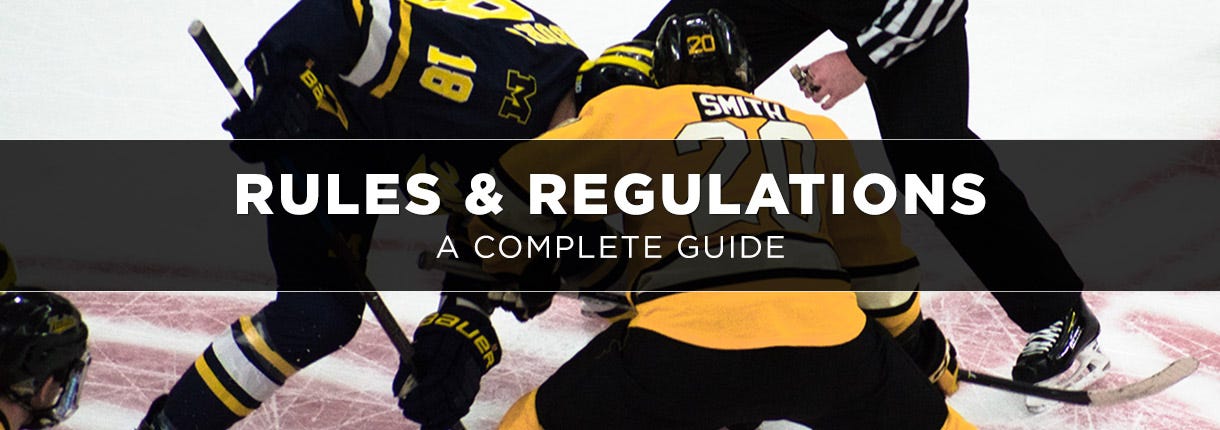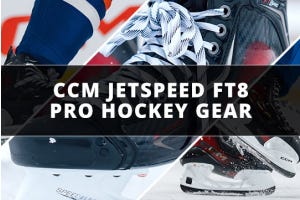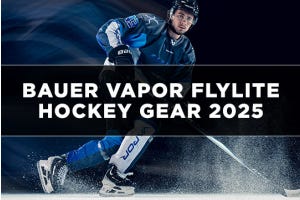Hockey Rules: A Complete Guide to Ice Hockey Rules & Regulations

Ice hockey is one of the most unique and exciting sports to play or watch, but some hockey rules can be confusing to players who are new to the game. We're going to provide a quick hockey for dummies guidebook to get you completely caught up on hockey basics and the major rules of hockey. We'll cover:
- Hockey Player Positions
- Equipment for Hockey Players
- Hockey's Main Rules
- Hockey Officials
- Hockey Penalties
- The Ice Hockey Rink
- Common Hockey Rule Questions
- Hockey Lingo
Hockey Player Positions
Ice hockey rules call for each team to have five skaters and one goaltender on the ice. A player's individual skillset often determines what position they’ll play. Faster skaters may play forward (playing offense and scoring most often) while the bigger, more physical players, who are excellent backwards skaters, usually play defense. The goaltender is most adept at stopping shots from going into the net.
Goaltender
The goaltender is the most specialized position in hockey. Goalies boldly face a barrage of pucks being shot at them over the course of the game. A goaltender undergoes special training, and wears unique gear, as the position requires a completely different skillset than any other player on the ice.
Defenseman
The defensemen's main job is to protect the goaltender and prevent the opposing forwards from shooting the puck on the net. Many defensemen are known for their ability to skate backwards and to take hard shots, known as slap shots, since they’re stationed on the hockey blue line when their team is in the attacking zone.
Wings
The wings are the two forwards who patrol the right and left sides of the ice. Their main job is to score or pass to other players who have a better opportunity to put the puck in the net.
Center
The center is responsible for the middle of the ice. They're also the players who face-off in the middle of the circle to get a play started. Centers are usually good two-way players and have numerous defensive and offensive responsibilities.
Equipment for Hockey Players
Basic hockey rules call for players to wear very specific equipment to prevent injury. The padding and protection players wear is designed to keep them safe, protecting them against flying pucks and sticks and collision with other players. All players must wear gear that conforms to hockey rules and regulations. Equipment doesn’t vary from player to player, except when looking at the goalie. A goaltender's equipment drastically differs from the other players on the ice.
Equipment for Skaters
Equipment for Hockey Goaltenders
- Goalie Skates
- Goalie Sticks
- Goalie Masks
- Goalie Leg Pads
- Goalie Catch Gloves
- Goalie Blockers
- Goalie Chest & Arm Protectors
- Goalie Pants
Hockey's Main Rules
There are many different rules of hockey play. Some are enforced for player safety and competitive play, while others exist to manage the flow and pace of the game while keeping play fair. The following three rules play a vital role in allowing the game to proceed smoothly and prevent players from taking advantage of unfair positioning on the ice.
- Icing: Icing is when a player in their defensive zone shoots or passes the puck before they reach the center-ice line, and it crosses the opposing hockey red line without being touched by another player. This rule forces teams to keep the game moving rather than just using long shots from one side of the ice to the other to run down the clock. A team on a penalty kill will not be penalized for icing.
- Offsides: The offside rule in hockey is when any player crosses the blue line into their attacking zone before the puck enters. The puck must always enter the attacking zone first. Some league’s rules, such as NHL hockey rules, allow all players in the zone to leave and return if the puck is shot over the blue line while they are in the zone. Once all players clear the zone, they may then enter and chase the puck. This is referred to as Delayed Offsides. Offsides was put into place to prevent opposing players from gaining an advantage by staying in the offensive zone without the puck.
- Offside (two-line) Pass: An offside pass, also known as a two-line pass, is when a player passes to a teammate and the puck crosses two lines on the ice surface. For example, a player in his or her own defensive zone cannot pass the puck over the hockey blue line and the center-ice line without it being touched by another player. This rule increases action by forcing shorter passes or making players skate with the puck in order to move towards the attacking side of the ice. This rule is not currently used in the NHL, but many leagues favor the offside pass rule to increase action on the ice.
Hockey Officials
The rules of hockey are complex, and there are many to be enforced. It takes an entire team of officials, both on and off the ice, to ensure that all hockey rules and regulations are followed during the course of a game.
Referee: A referee is also considered the main on-ice official. He or she is in charge of the officiating crew and responsible for calling any penalties that occur. Refs are easily identified by the orange bands worn on the sleeves of their uniform. In some leagues, there may be two referees on the ice to allow officials to enforce the rules of game more diligently.
Linesmen: A hockey linesman has one main responsibility – to watch the play at the blue lines so that offsides, offside passes and icing can be called correctly. At most levels, linesmen cannot call penalties; they must report certain incidents, such as misconduct, to the referee at a stoppage of play. Some amateur leagues and youth hockey rules allow the linesmen to call penalties that the referee may not be able to see. There are usually two linesmen on the ice, one patrolling the neutral zone in front of the benches, and the other on the opposite side of the ice near the penalty boxes.
Goal Judges: A goal judge in hockey has one sole responsibility – to watch the puck and report when it crosses the red line into the net. Games that employ goal judges will have one judge for each end of the ice. With modern technology, some goal judges may not need to be at ice-level, but instead will just monitor the goal area via a video camera and monitor.
Official Scorer: The official scorer in hockey is responsible for recording all the events that occur during the game, not just the scoring plays. The official scorer records goals, assists and penalties. For each goal, they must mark the exact time a goal is scored, the number of the player who put the puck in the net and the number, or numbers, of any players who assisted on the play.
They must also record the time a penalty is committed, the number of the offending player, what the penalty was for, when their penalty started and what time their penalty ended.
In many cases, the official scorer will also record the number of shots-on-goal for each period, as well as the total number of shots and saves at the end of the game. The exact time for each shot is generally not required.
Hockey Penalties
There are multiple penalties that are called in hockey – each is classified as a type of penalty and has its own severity.
Penalty Classifications
Minor Penalty: A minor penalty in hockey is two minutes and the offending player must serve his or her time in the penalty box until that time is up or the other team scores.
Major Penalty: A major penalty in hockey is five minutes and the guilty player must sit in the penalty box for the entire five minutes even if the opposing team scores.
Misconduct: A misconduct penalty in hockey is served for 10 minutes. Depending on the league’s hockey rules, the offender’s team may or may not be short-handed for the entire 10 minutes.
Penalty Shot: A penalty shot may occur when a player with a clear path to the net (this is known as a breakaway), with no one in front of him or her except the goaltender, is stopped from behind by illegal contact. The player will be given one chance for a one-on-one confrontation with the goaltender with no other players on the ice.
Delayed Penalty: A delayed penalty occurs when one team breaks one of the basic hockey rules, but does not gain possession of the puck. The play will be stopped and the player penalized when the team finally touches or gains possession of the puck.
Types of Hockey Penalties (and their signals)
The type of penalty called depends on severity and intention. The more severe, or worse the intent (intending to cause injury, for example), the worse the punishment will be.
Boarding: Boarding is when one player causes another to crash into the boards due to illegal contact.
Charging: Charging is when a player takes extra strides to gain momentum before checking another player.
Cross-Checking: Cross-checking is using the stick while initiating a body check.
Elbowing: Elbowing is forceful contact with an elbow during play.
High-Sticking: High-sticking is using a raised stick to make contact with an opponent.
Hooking: Hooking is using the curved blade of the stick to hinder an opponent's ability to skate.
Holding: Holding is grasping another player or his or her uniform.
Interference: Interference is contact that restricts the movement of another player who does not have the puck.
Misconduct: Misconduct can refer to any type of severe hockey penalty, such as verbal abuse of a player or official, argumentative behavior or disrupting the game.
Roughing: Roughing is unnecessary physical play like throwing a punch or shoving a player.
Slashing: Slashing is illegal use of the stick by swinging it at an opposing player.
Spearing: Spearing is called when one player thrusts his or her stick into a player on the other team.
Tripping: Tripping occurs when a player is tripped by his or her opponent with the leg or stick.
Washout: An official makes the washout signal to indicate that icing or offsides is being waved off and play will continue.
The Ice Hockey Rink
The playing area for an ice hockey game is unique in the fact that hockey regulations allow for play to be confined by the boards and players may jump in an out of play while the action is still moving. There are many intricacies to the ice hockey rink.
Ice Hockey Rink Dimensions
The standard hockey rink used by the NHL is 200 feet long by 85 feet wide. There may be variations that are smaller or larger at your local ice rink, and Olympic rinks are a bit wider.
Lines on a Hockey Rink
The Red Line: There is a hockey red line at each of the far ends of the rink. The line passes through the front of the goal, marking where the puck must cross to be counted as a goal as it goes into the net. This is also the line that notes where the puck crosses for icing to be called.
The Blue Line: The hockey blue line separates the attacking or defending zone from the neutral zone. A player must be on the neutral side of this line before the puck enters, or else he or she will be considered offside.
The Center Line: The center line divides the ice rink in half. The game begins with a faceoff at the center dot in the middle of this line.
Ice Hockey Zones
Attacking Zone: The attacking zone is also referred to as the offensive zone. This is the portion of the ice where a team is trying to score.
Neutral Zone: The neutral zone is the area of the ice between the blue lines, where teams transition from offense to defense.
Defensive Zone: The defensive zone is portion of the ice where a team is trying to prevent goals from being scored.
Goalie Trapezoid: The goalie trapezoid is a marked off section behind the net. The goalie cannot play the puck outside of this area behind the red line.
Faceoff Dots and Circles
There are nine faceoff dots and five circles on the ice; one dot at center ice, four on either side of the rink in the neutral zone along the blue lines, and two in each attacking and defending zones. Whenever there is a stoppage of play, the game is resumed by a faceoff at one of these dots. Only the centers, the players taking the faceoff, are allowed within the circles while the puck is being dropped.
Hockey Goals: Post, Net and Crease
The hockey goal is the netted apparatus the puck must enter in order for a goal to be scored. It is constructed of two posts, a crossbar (the bar at the top connecting the posts) and a net to contain the pucks that enter. The goal crease is the area of ice where a goaltender can play without interference.
Hockey Goal Dimensions
A standard hockey goal opening is six feet wide by four feet tall. A smaller goal is often used for younger hockey players.
Hockey Goal Area
In front of the net is a blue area that’s referred to as the crease. This is the goaltender’s area, and no player is allowed to interfere with him or her while they are in this area. Ice hockey rules do not allow any player other than the goaltender in the crease unless the puck is loose in the blue paint. Players violating this rule risk having any goal they may score taken away due to them being in the goaltender’s protected zone.
Goaltender Trapezoid
Also known as the Goaltender Trap Zone, there is a trapezoid outlined behind the goal – this is the only area behind the net where the goaltender is allowed to play the puck. If he or she strays outside of this area, they will be called for delay of game.
Referee Crease
In front of the official scorer, there is a section marked off for a referee to speak with the scorer or timekeeper without interruption. If the referee is conferring with an off-ice official, players may not enter this crease.
Bench
The bench is where players sit when not in the game. There is usually a door at either end for players to enter and exit the ice. Players may also hop over the short board separating the bench from the ice in order to enter the game quickly.
Penalty Box
The penalty box is a closed off section, usually next to the score and timekeeper's booth, where a player guilty of a penalty must serve their allotted time.
Glass
The hockey rink is encircled by glass except at the benches. This allows spectators to view the game without the risk of pucks, sticks or players leaving the ice surface.
Half Boards
The term half boards refers to the boards in the attacking and defending zones between the red line and the blue line.
Common Hockey Rule Questions
How long is a hockey game?
NHL hockey rules specify a game has three 20-minute periods, plus overtime if necessary. Youth leagues generally have shorter periods, and sometimes non-professional leagues may shorten or lengthen the game time due to how much ice time they have allotted for their game.
Why do some goals have more than one player credited with an assist?
In hockey, up to two players can be given an assist on a scoring play. These are the last two players to touch the puck on the play before the puck is passed and a score is made. If an opponent touches the puck in between two passes, only the one player (the last player to touch the puck before a final player scores) will receive credit for an assist.
What is a puck made out of?
A puck is constructed from vulcanized rubber. It is often frozen before games to prevent it from bouncing.
Are ice hockey rules the same at all levels?
No, there are many variations of the standard hockey rules. Some leagues, like youth leagues, limit contact. Young players may also play half-ice games rather than use the entire sheet of ice, and offsides, icing and hockey basics may be altered depending on age and level of play.
Are all hockey sticks the same?
No. In fact, hockey sticks have become very personalized to each player. There are several different curves of blade that can change how a puck is handled and shot, and most sticks flex, meaning they bend when pressure is applied. The amount of flex changes how much snap happens when a puck is shot. Some players like springy sticks, while other prefer a stiffer stick.
How many penalties can be called on a team at one time?
The referee can call however many penalties occur. However, one team will never have less than three skaters on the ice at one time.
What happens if a goaltender receives a penalty? Will the team have play without him or her?
If a goaltender is penalized, another skater must serve his or her time so that one team is not without a goalie.
Hockey Lingo
Faceoff: Faceoffs are the start of play. A player from each team lines up at a faceoff dot, and an official drops the puck in between them as each attempts to gain possession.
Body Check: Using your body to knock a player off the puck.
Deke: A fake move or deceptive play with the puck on a player’s stick in an effort to trick a defender.
Wrist Shot: A quick shot that’s fired off by pressure on the stick and a flick of the wrist.
Slap Shot: A hard shot taken by winding up and slapping the puck towards the net. Some NHL players can get the puck to reach 100 MPH using this shot.
Hat Trick: A hat trick occurs when a player scores three goals in the same game.
Power Play: When a team has the advantage of having more players on the ice than their opponent due to a penalty.
Penalty Kill: The time when your team has lost a player due to a penalty and you must play with fewer players than the other team.
Stick Handling: The use of a stick to control the puck while skating.
Save: A save, also called a stop, is when a goaltender prevents a shot from entering the net.
Breakaway: When a skater has a one-on-one opportunity against the goaltender.
Wraparound: A wraparound is a scoring chance when a forward has the puck behind the net, skates quickly around the side and tries to sneak the puck past the goaltender into the net.
Five Hole: The five hole is the small opening between the goalie’s legs.
Top Shelf: Putting a puck in the top shelf is a reference to a shot that hits the top of the net, especially from close range.
Shootout: Some leagues utilize a shootout to break game ties at the end of the third period. The shootout consists of a series of penalty shots, skater versus goaltender, to decide a winner.
Biscuit: Biscuit is a slang term for a hockey puck.
Slot: The slot is the section of the ice in front of the goal crease. The slot is sometimes broken down into the high slot (further away) or low slot (closer to the net).
Intermission: The intermission is the allotted break in between periods for players to rest and coaches to make adjustments.
Changing on the Fly: Changing on the fly refers to the substitution of players while the clock is running and action is still occurring on the ice.
Pulling the Goalie: Sometimes in desperation when losing late in a game, a coach will decide to pull the goaltender in order to have a sixth skater on the ice. This leaves the net wide open, but also gives one team an extra skater.











